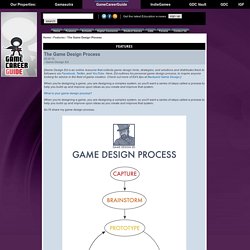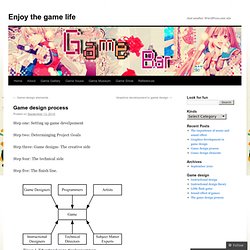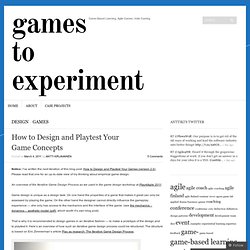

Easy To Learn, Difficult To Master: The Perfect Recipe For Game Design. Atari founder Nolan Bushnell made a claim way back in the '70s that a game should be easy to learn but difficult to master, and this is a pretty perfect recipe for making titles that are continuously engaging.

Most of us regular gamers have likely been there — a game starts off on a strong foot and is super exciting as you encounter new opponents, weapons, or lore. But after a while you start wondering why you're not as amped to play the game as you used to be. In extreme cases, this might result in you simply never starting the game up again. Obviously there are a near infinite number of ways for why this could happen.
Anything from a lack of leisure time, to a storyline or genre that you realize just isn't gelling with you, or gameplay mechanics that frustrate you. The Game Design Process- GameCareerGuide.com. [Game Design Ed is an online resource that collects game design hints, strategies, and solutions and distributes them to followers via Facebook, Twitter, and YouTube.

Here, Ed outlines his personal game design process, to inspire anyone looking for advice in the field of game creation. Check out more of Ed's tips at Backyard Game Design.] When you're designing a game, you are designing a complex system, so you'll want a series of steps called a process to help you build up and improve upon ideas as you create and improve that system. Creating a game concept without coding skills: Our very first PixJam. Nikita Guk is chief strategy officer at Pixonic.

We recently held the first game concept design jam in our company and I want to share our experience. The main idea was to push our own limits and foster the inner creativity of as many of our co-workers as possible - even those not involved in game design or who have zero coding skills. How a Tweet Turned Into the Best New Multiplayer Game in Years. Josh Valcarcel/WIRED Screenshot: Other Ocean Interactive One of the weirdest, coolest, most hyped multiplayer games in years is here, and it started with a tweet: “Contemplating building a game entirely with friends on twitter/fb.

Totally open and ‘Mad Lib’ style. [Dev Tips] 6 lessen uit gamejams: “Omarm de inspiratie!” Features - Paper Burns: Game Design With Agile Methodologies. A fear of next generation development can be seen everywhere; it’s at the water cooler, it’s in magazines, it’s talked about at the Game Developers Conference and in Magazine.

With increased hardware capacity allowing for ever more expansive and immersive games, everything is growing: Team sizes, asset requirements, person hour investment, and of-course required capital from investors to support it all. Audiences are also expecting more. They want more mechanics with greater functional and technical depth, denser polygon art, higher resolution textures, more complex AI, more testing and quality assurance, and the list goes on. Game design process. Step one: Setting up game develpoment Step two: Determinging Project Goals Step three: Game desigm- The creative side.

How to Design and Playtest Your Game Concepts « Game-Based Learning Dev. Notice: I’ve written the next iteration of this blog post: How to Design and Playtest Your Games (version 2.0).

Please read that one for an up-to-date view of my thinking about empirical game design. An overview of the Iterative Game Design Process as we used in the game design workshop at Play4Agile 2011. My design method: Interweaving « #AltDevBlogADay. Warning: there might be a couple of light spoilers, but everything is in the trailers anyway so… nevermind that.

I hope what I’m going to say won’t sound too stupid, agreeing with everybody and not making a fool of myself is really hard. n_n That being said: DON’T duct-tape features together to make Frankenstein-style abominations.DO find natural sources of gameplay/setting harmony and consistency.DO identify the axes from which your game is built in order to know what you should and shouldn’t do (it also works for other forms of intellectual construction). Interweaving This has been my main design paradigm and method for the past year. There are 4 main axes that need to be taken into account when using this model: Perimeter, Exploitation, Justification, and Legitimacy.
Simply put: find a nice place to dig (like a goldmine), and DIG deep, don’t just scratch the surface. I realized later that that described very precisely what QUALITY is about. Let me explain. Lost Garden. Evolutionary Design A practical process for creating great game designs Page 1 of 6 Table of Content Page 1 Table of Contents Introduction Board Games and Novel Writing Page 2 Giants and Castles, The Evolutionary Process The Death of the Ego Page 3 Focus on a fundamental activity Play the Game Observe the Game Page 4 Identify Problems with the Game Common Economic Issues Common Psychological Issues Page 5 Create new rules The Life Cycle of an Evolutionary Design Expanding the Evolution Metaphor Page 6 Using Evolutionary Design for computer games A Proven Technique The Benefit of a Process References Introduction Game design, in its most pure sense, is the creation of the rules that govern the gaming environment.

The successful creation of these rules is not magic. First I made the relatively safe assumption that people exhibit predictable responses to reproducible situations. [Mind-Speak] » Blog Archive » Project Aurora – Creating the Concept. If you’re like me, you love seeing how other people design.
![[Mind-Speak] » Blog Archive » Project Aurora – Creating the Concept](http://cdn.pearltrees.com/s/pic/th/archive-project-creating-40655298)
Here’s the process – and the docs – from the first stages of development on my latest indie endeavor: Project Aurora. The Spark. The Elusive “Quick Iteration”: Tips for Indie Devs « #AltDevBlogADay. From agile and scrum to extreme programming, everyone’s trying to nail down what it takes to iterate on products quickly and efficiently.
There are a lot of methodologies that you can employ to guide you through shipping products. But today, I’ll be talking specifically about video games and how, as a developer, you can use a loose process and follow some basic rules in order to get quality games quickly out the door. You might argue that in today’s day and age, with the Valves and Blizzards of the world, that taking your time speaks volumes for the quality of a game. 10 Game Design Process Pitfalls. Sita Vriend's Blog - Curiosity killed the Warlock. The following blog post, unless otherwise noted, was written by a member of Gamasutra’s community. The thoughts and opinions expressed are those of the writer and not Gamasutra or its parent company.
Curiosity is the pleasure of learning and not knowing. It sparks the desire to learn or the desire to figure out how stuff works. Theory and Principles of Game Design: Emotions in Games. Authors and filmmakers who wish to evoke particular emotions in their audience often rely on the audience's ability to empathize with the characters portrayed in the narrative, and especially with the protagonist. The author sets up situations in which characters experience particular emotions in the hope that the audience will themselves have similar feelings, or at least understand why the characters feel the way they do. The author is in control of the characters' emotions, while the audience's emotions derive from sharing in those characters' feelings and experiences. Features - Understanding Challenge. What is challenge? Talking about challenge is difficult when the vocabulary we have is limited to "physical" or "mental.
" It doesn't give us the necessary tools to examine games with any sort of substance. The Mechanics-Dynamics-Aesthetics (MDA) framework states "Charades emphasizes Fellowship over Challenge; Quake provides Challenge as a main element of gameplay. "1 We inherently recognize that the challenges between these games are significantly different, but there is no language available to explain that difference. Five Ways Games Appeal to Players. I once happened upon my brothers attempting to fly an SUV off a cliff. This was years ago, when Grand Theft Auto III was still new, but it was already easy enough to search online for the cheat code to make cars fly.
After about an hour of trying to glide across a river and into a football stadium, they finally cleared the edge of the wall, landed the car inside, and broke into proud laughter upon discovering the Easter egg inside: an image of fans spelling out the name of Liberty City's football team: "COCKS". Ethics in Gaming 1.0. The collected game design rants of Marc LeBlanc. Game Design: 8 kinds of fun. Why Behavior Change Apps Fail To Change Behavior. Research. Flow, Player Journey and Employee Satisfaction - Andrzej's Blog.
Game Design: 8 kinds of fun. Real-Life Skills We Learn From Gaming. “Video games are a waste of time”. If you’re a gamer, you’ve probably heard this sentence many times throughout your life, often from a partner who’s upset they’re not getting enough attention. Of course, this isn’t the only instance where one might hear the phrase. Parents, teachers, and just non-gamers in general are fond of belittling our favorite pastime. I’ve never really let it get to me, as I feel that the same could be said about any form of entertainment, but also because I just don’t believe it to be true. Although most people play games for fun only, there are valuable lessons to be learned that can be carried over into real life. Hand-eye Co-ordination This is the most obvious of the bunch, so I listed it first. Problem Solving. The Origins of Flow. As a reader of MP, there's a decent chance that you're already familiar with the concept of "flow" championed by positive psychologist Mihaly Csikszentmihalyi (pronounced like this, not this).
If you aren't up to speed on it, fear not; I'll go into the details in just a moment. The notion is immensely popular among game designers and theorists, whether they want to leverage games' power to put us into a flow state to pursue social good, are using psychophysiological tools to quantify flow and keep players in it, or simply using it as the blueprint for good game design. But as much as the games community wants to take flow as its own, there's more to the story. Refining the flow diagram. Last month, I posted on the origins of Csikszentmihalyi's concept of flow, but the diagram I focused on there (and that tends to pervade discussion of flow among game designers) is actually a bit dated.
Preparing for a reading group on engagement here at IU, I came across this very readable chapter from the Handbook of Positive Psychology, in it was introduced to a much more nuanced version of the Flow Diagram. If you're familiar with the classic flow diagram, you might notice it has some deficiencies. Most notably, the experience of being in a high-skill, high-challenge state is markedly different that a low-skill, low-challenge state, even though both fall within the so-called "flow channel". Features - Fun is Boring. Games Are Not Experiences. The Joys of Gaming [Game Design. Features - Intuition, Expectations and Culture: Learning from Psychology to Build Better Game Interfaces. Features - Cognitive Flow: The Psychology of Great Game Design. Designing Meaning in Games » #AltDevBlogADay.
Integrated Design for Games. Shadow Emotions and Primary Emotions. July 2011. Triple Town Beta (Now with Bears) Games are not like real life - human psychology in games.